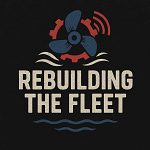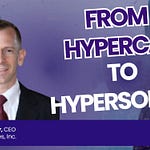Is the Department of the Navy Taking the Lead in Defense Acquisition?
About Justin and Artem
Justin Fanelli serves as the Navy Chief Technology Officer and has earned a reputation for dismantling bureaucratic barriers that traditionally slow defense innovation. Coming from a technical background, Fanelli has developed new mental models for technology adoption within the Department of the Navy, including a structured approach to piloting, evaluation, and scaling of emerging technologies. His work focuses on creating transparent, outcomes-driven processes that empower change agents across the department.
Artem Sherbinin serves as the CTO for the Naval Surface Force, implementing modernization strategies on the front lines. His operational background as a navigator and operations officer on a Navy cruiser gives him a warfighter's perspective on technology risk. This experience has shaped his approach to innovation, with an emphasis on addressing real operational needs rather than satisfying bureaucratic requirements. Sherbinin works three echelons below Fanelli in the Navy's organizational structure, yet their collaborative approach demonstrates the cross-functional alignment driving today's modernization efforts.
About the U.S. Navy’s Modernization Efforts
The Navy has time-bound its modernization imperatives through the Navigation Plan, which identifies nine critical capability gaps that must be addressed by January 1, 2027. This date wasn't chosen arbitrarily—it aligns with China's publicly stated timeline for Taiwan readiness. As Sherbinin noted, "We've even hung up clocks. They're counting down to January 1st, 2027."
To structure this effort, the Navy has implemented a "Horizons" framework for innovation:
Horizon 3: Active scouting of emerging technologies
Horizon 2: Piloting promising solutions
Horizon 1: Scaled production
There is an additional fourth horizon focused on divestment of legacy systems that we did not discuss at great length.
This approach enables the Navy to engage with technology at different stages of maturity while maintaining focus on mission outcomes. War games consistently show that the Navy's “program of record force” struggles against China, but that same force augmented with emerging technologies from startups "does win more often than not."
The Navy's modernization strategy goes beyond just adding new technologies to existing platforms. As Fanelli emphasized, "No one's going to replace large capital assets like warships. You are always going to have to have a $1.8 billion guided missile destroyer, but a $1.8 billion guided missile destroyer augmented with unmanned systems, complicated electronic warfare, software-defined radios and things like that is going to be 10 times more effective than the destroyer on its own."
Key Takeaways
Speed Reduces Risk: Contrary to traditional defense acquisition thinking, the CTOs believe that faster acquisition cycles actually reduce risk. By adopting rapid piloting approaches with clear success criteria, the Navy can make evidence-based decisions quickly rather than spending years on requirements development only to discover misalignment with actual needs. This reframing of risk—focusing on risk to the warfighter rather than programmatic risk—is enabling faster capability delivery.
The Triangle of Successful Pilots: Every successful technology pilot requires three elements working in concert: a pilot lead to run the program (often from a tech adoption organization), a portfolio transition partner with operations and maintenance funding to enable long-term adoption, and an operational sponsor who can validate the capability's impact from a warfighter perspective. As Fanelli explained, "It's very hard to do that without the triangle being complete. But if you pour money and gas on that, we can go really fast now." This three-part structure ensures that successful pilots have a pathway to scale beyond one-off demonstrations.
Produce Results, Not Proposals: Rather than defining exhaustive requirements documents and then evaluating compliance, the Navy is embracing competition between vendors based on demonstrated performance. "We leverage market forces and have industry compete against each other and us as the government be the facilitator." Artem reinforced that "competition does not happen on slides, to get from Horizon 2 to 1, you are demonstrating something at sea." This approach favors companies that can rapidly deliver working capabilities over those that excel at proposal writing.
User-Focused Metrics Drive Adoption: The Navy has shifted away from measuring success based on adherence to requirements toward measuring actual operational impact. “Where do you move the needle on our mission outcomes? So operational resilience, where do you make us more adaptive? Where do you save thousands or tens of thousands or hundreds of thousands of sailor or marine hours?” This outcomes-focused approach provides the evidence needed to overcome institutional resistance to change.
Cultural Change Requires Both Policy and Proof: The recent Software Acquisition Pathway memo from the Secretary of Defense has been instrumental in empowering change agents across the enterprise. Artem observed, "That memo just empowered a whole lot of people who have wanted to do the right thing and couldn't." However, policy alone isn't enough—the Navy is actively building a portfolio of success stories that demonstrate the value of new approaches. When these "ass-kicking wins" are documented with both user feedback and quantifiable metrics, they create momentum that overcomes institutional inertia.
The Navy's approach to modernization represents a significant departure from traditional defense acquisition models. Rather than treating technology insertion as a decades-long process managed through rigid acquisition processes, the CTOs are creating pathways for rapid adoption of commercial capabilities while maintaining appropriate oversight and evaluation. The urgency of the 2027 deadline has created a forcing function that aligns budgetary, technical, and operational stakeholders around common goals and timelines.
Most importantly, this approach is already delivering results. From unmanned surface vessels being tested in multiple fleets worldwide to advanced edge computing enabling new capabilities on ships in the Red Sea, the Navy is demonstrating that institutional innovation can happen at a pace that meets the demands of great power competition.
For more about Justin: LinkedIn
For more about Artem: LinkedIn
For more Crossing the Valley:
YouTube: https://www.youtube.com/@crossingthevalley
Substack: ValleyCrossers.com











